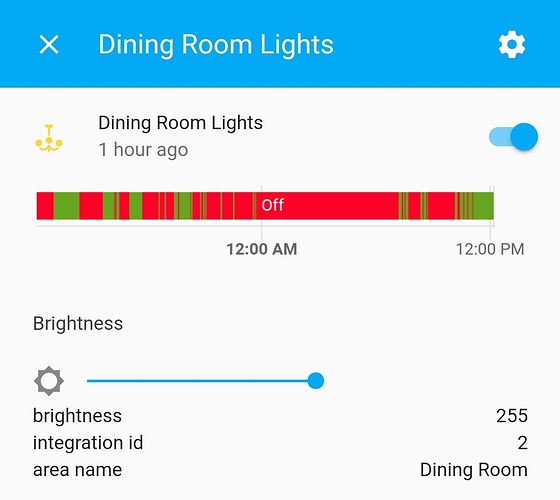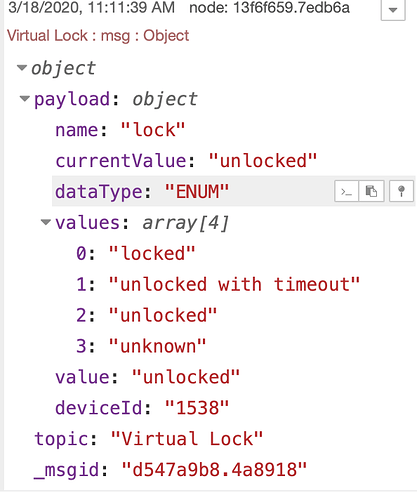On a quick test, it seems to be working/fixed. Nice work!
In my two week failed experiment in Home Assistant, I noticed that they had horizontal time bar graphs for each device that would indicate when a switch is on/off, motion is active/inactive, and doors are open/closed. I erased Hassio on my other Pi so I can't post a picture of what I am referring.
If you know what I am talking about, do you think it's possible in Node Red Dashboard or do something similar on a Dashboard? I would love a way to graphically see what my devices are doing over time.
In Node Red, I have seen ways to track when the states are values such as temperature but, how could you graph your switches, motion sensors, contact sensors, thermostats, etc that have a string as a status, not a number?
This is what @stephen_nutt is referring to:
Yes that!!!!!! Thank you.
If you're using Lutron Caseta devices with Node-RED, consider adding the node-red-contrib-lutron node.
Directly communication between the NR computer and the Caseta Pro bridge (rather than NR computer <--> Hubitat <--> Caseta Pro bridge), makes lighting automation super fast.
Here's an example:

The time-lapse between a HE-paired z-wave motion detector detecting motion and light turning on (reported by Lutron Telnet) is just 115 ms. It takes a further ~140 ms for HE to report the light is turned on.
Thanks for the details @aaiyar. Does that node capture events from Caseta remotes as well?
Sadly no. And I contacted the developer. But didn't hear back.
(it captures event from the remotes if they're paired to another Caseta device in the Caseta app - which is basically useless for my purposes).
Drat!
Ah well, still got other options there thankfully.
I tried it a while back but could never get it to work. The documentation is severely lacking. No explanation of inputs or outputs for the 2 node types. I wanted to use it for my Picos. I only have Picos and then a plug solely used as a repeater.
I did notice this when i click on the installed pallete:

And then @fblackburn came along and we have his nodes and all is right with the world!
Took me a little white. And sadly, it has no support for unpaired Picos - which sucks.
Agreed. Took me a little while to get this.
For the control node, you can set msg.payload to whatever dimmer value you wish (100 = max, 0 = off). For on/off switches, use 100 for on, and 0 for off.
The status node outputs msg.payload as a number (100 = on, 0 = off, anything in-between = dimmer level). The status node will give no response from Picos that aren't paired to dimmers or switches in the Caseta app. Therefore, the status node is really outputting what the Caseta switch/dimmer is doing, and not the Pico. I wish the author of that node would change it, but ......
Thanks. Since that is the case, it's useless to me and you saved me wasting any more effort trying to get it to work.
Did a little Googling. There's an updated version node-red-contrib-lutron on GitHub. Use that instead - it works with unpaired Picos!
P.S. Also has a nice icon for the control and status nodes. Not that it really matters, but hey - why not.
The two button Picos give you on/off. The five-button Picos give you a percent from 0 to 100.
Do i just copy the folder in the zip file and replace the one already in the .node-red folder?
Yup. And then restart Node-RED.
Anyone try any of the presence/location options for node-red?
I am one app away from retiring one of my Hubitat hubs... Life360.
There aren't any (good enough) Life360 node-red nodes, so I guess I need to either live with that hub existing for that single function, or find an alternative (that works as well as Life360 - which works flawlessly for me).
Maybe I'll poke around with OwnTracks a bit since I now have more free time (14 day quarantine from work. blah). Only hurdle is I need to make a 2nd internet facing MQTT server and bridge it to my main MQTT server. Not hard to do, just haven't had time (until now maybe).
I know I mention it in a lot of my posts but, if you have a an Android, Tasker does a great job for me. It's not as pretty as Life360 with all the bells and whistles but it does a good job updating whether I enter or leave a geofence. And you can set up a geofence anywhere you want and have an unlimited number of them. I create a virtual presence then send http requests as I enter a geofence and exit a geofence. It doesn't require Node Red though.
I messed around with Bluetooth (iPhones connecting/disconnecting from a couple of rPi Bluetooth radios in different parts of the house), publishing connect/disconnect transitions via mqtt.
I started with https://github.com/andrewjfreyer/monitor, and tinkered from there. Stored the state changes for each monitored phone in Influxdb, adjusted timeouts, examined the history, repeat, etc. but could not make a reliable presence detector out of it with only two rPi nodes.
Seems like it has potential...
I went ahead and setup a cloud MQTT server and one-way bridge to my local MQTT server, and setup OwnTracks on one of my phones.
I'll test it out for a few days and see how it works.
I'm having an issue with detecting unlock with a lock code.
Never mind - I had the device node misconfigured
I'm relatively sure this was working in 0.0.24. However, in 0.0.26, when I unlock with a code, all I'm seeing is this:
This looks interesting, but I wouldnt know how to set up the other end.



